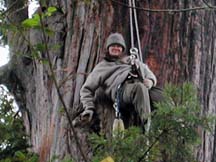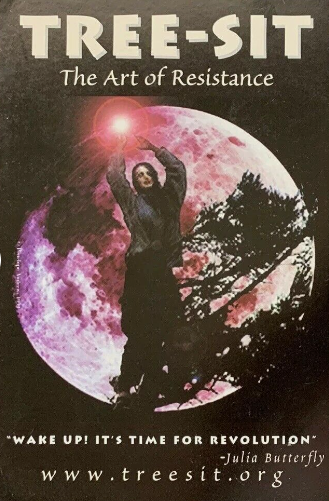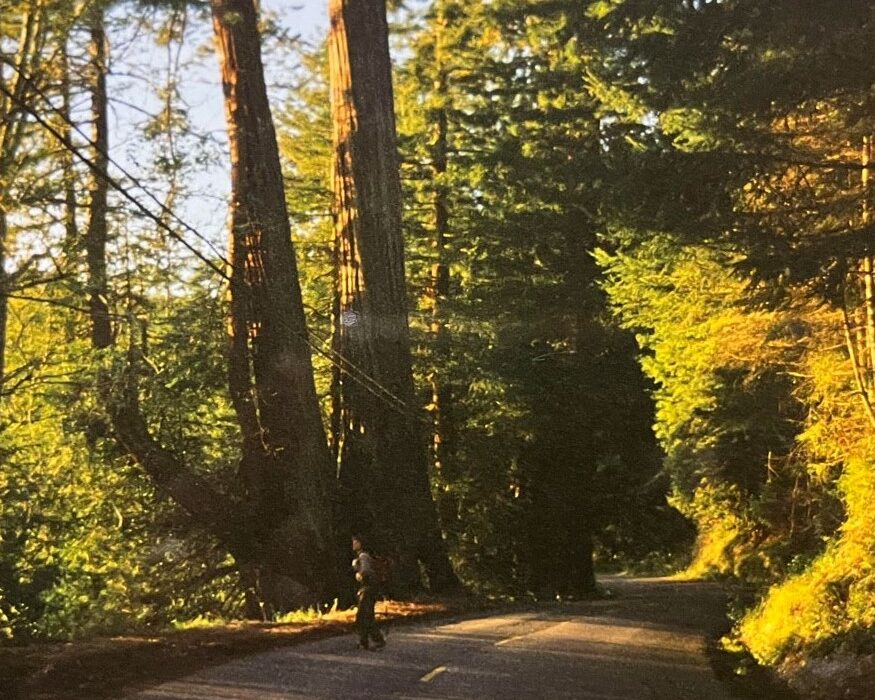On the cell with 'Remedy'
Text and photo by Bob Doran, North Coast Journal, March 6, 2003. Image of ‘Remedy’ dangling on a rope tethered to her Freshwater home, a tree named Jerry.

THE 200-FOOT-TALL REDWOOD REMEDY CALLS home is emblazoned with graffiti. The tree’s name, Jerry, and hers were painted on the trunk by representatives from Pacific Lumber, the company that owns the tree — and, as Remedy pointed out, most of the Freshwater watershed.
The 28-year-old woman lives on a makeshift platform 130 feet up the tree, not far from Greenwood Heights Road. Jerry (a moniker chosen by another activist in honor of the late rock legend Jerry Garcia) stands in the “Upper Village,” a collection of four tree-top platforms on the edge of a proposed clear-cut officially known as Timber Harvest Plan 01-451.
Born and raised in Michigan, Remedy hit the road after high school, eventually settling in Olympia, Wash. Living near the rainforests of the Olympic Peninsula, she grew to love the woods and learned something about the battle over the remaining old-growth forests.
Before coming to Humboldt County she was working in a bookstore, dabbling in astrology on the side. When vacation time came around in the summer of 2001 she decided to volunteer helping the activists who were trying to stave off logging in the Mattole watershed. The action was hot and heavy when she got there: People were barricading roads, getting thrown in jail. The self-described “never-been-arrested middle-class girl” stayed out of trouble.
Due back at work on Sept. 12, she changed her mind about returning once the Sept. 11 terrorist attacks happened. “I felt like I needed to do something. There are so many problems in the world. I picked this one,” she said. She decided to become a full time “forest defender.”
The conversation below took place last week via cell phone, Remedy’s lifeline to the outside world. She’s on it all day calling a wide range of people: her mother back in Michigan, general supporters, representatives of local environmental groups. To talk to fellow tree-sitters in the “Lower Village,” located nearby in a different cutting unit, she uses a more primitive communications device: a walkie-talkie.
She talks often with reporters. In recent weeks she’s been on the line with a CBS reporter from Los Angeles and with a Ladies’ Home Journal correspondent, who asked about her housekeeping. She said she’s willing to put up with questions about cooking or the lack of showers, as long as she can squeeze in her opinions on topics like clear-cutting and the importance of old growth trees.
She uses the platform she lives on, in other words, as a platform for her strongly held opinions. While she’s been getting some media attention, it pales in comparison to the notice Julia Butterfly Hill — the world’s most famous tree-sitter — enjoyed during her two-year occupation of Luna, a redwood near Stafford. The novelty, evidently, has worn off.
—
How long has your tree been occupied? Was there someone there before you?
The first time I saw this tree I was just compelled to climb, I don’t know how else to describe it. The first person sat up here for a night or two, then I came up and sat for about four days. Then I went back down to the ground. [At that point] the question I was asking myself was `What do I do? What is the most effective thing that I, personally, can do?’ All indications were that I should sit in this tree, so after being on the ground for five days I came back up. That was March 21 last year. My feet haven’t touched the ground since.
That must be hard.
Living in a tree is hard work. It’s really special and amazing — and by far the coolest thing I’ve ever done — but it’s not easy.
Do you ever feel like you’re in solitary confinement?
I do. And at times I’ve used that analysis to understand the fact that I can do this. There are people who really are in solitary confinement, and they’re not up in a beautiful tree overlooking a 20,000-acre watershed, they’re locked in a basement with no windows and no clean air.
And no cell phone
Yeah, no cell phone and no people driving by saying `We love you.’ People who are confined like that do it for years. If they can do it in those kind of conditions, I can certainly come up here and survive in this tree. I get nourishment from the fact that I am resisting the ecological collapse that is being wrought upon this community by a corporation that has taken over way more than just the Pacific Lumber Co. They also seem to have taken over the California Department of Forestry and the [North Coast Regional] Water Quality [Control] Board, and everyone else that is involved with approving the thousands of acres of clear-cuts.
You make it sound like some vast conspiracy controlled by MAXXAM [Pacific Lumber’s parent corporation].
I don’t know if I would call it a conspiracy, but there’s no question that it’s corrupt. If the water quality board was really interested in protecting our water, they would not be cowed by pressure from Pacific Lumber. And if the Department of Forestry was really protecting the health and integrity of the forest, they would not approve every single THP that comes across their desk, especially when it involved steep and unstable slopes, or clear-cuts, which go hand-in-hand with herbicides and diesel fuels.
At Thursday’s Water Quality Control Board meeting, PL got a waiver on sediment discharge for THP 01-451, presumably clearing the way for more logging. What does that mean to the tree villages?
I feel like we’re on high alert now that Water Quality has crumbled at the feet of PL — again.
What does “high alert” mean?
It means I’m sleeping very lightly, I’m up early in the morning, I’m very watchful for any hardhats coming towards the tree. A lot of people are sleeping next to their phones; we have a huge list of people who are ready and willing to respond if the tree-sits are threatened or if climbers are sent up. I have everything at hand in case they come so I can defend the tree. They’re not going to catch me unawares.
In the lower village they’re talking about lock boxes to attach themselves to the tree-tops. Do you have something like that? With a tree that large it wouldn’t seem like you could lock yourself to it.
It’s true, I am in a huge tree. I don’t want to talk too specifically about what tactics I’m going to use, but they are going to have a very hard time getting me out. They will have to endanger my life to do it. Of course, when a climber comes up your tree, you know your life is immediately in danger, because there’s nothing safe about evicting a person [from a tree] especially when tactics like pain compliance and zip-tied hands behind your back are being used.
Are the trees in the upper village connected by traverses the same way as in the lower village?
There are ropes connecting this tree to Wren’s tree and a tree in between us.
So you can go from tree to tree.
People do that, but I haven’t left this tree for nearly a year. That’s my tactic.
And so far your tree is still standing
It’s true, this tree hasn’t been cut down. But they used about an entire can of orange and white spray paint on it.
What did they paint?
On my tree is says Remedy in bright orange letters. It also says Jerry, like three times, and the number 11 a bunch of times. They numbered all the tree-sits.
They?
Pacific Lumber; Carl Anderson, head of PL security was with them. Who knows what it means. I think it’s a threat. It’s intimidation. You know, they’re powerless. They want to come and get me, but they can’t because they don’t have the skills. They don’t know how to climb [Pacific Lumber uses hired climbers]. So instead they desecrate these ancient trees. This is like a 1,200-year-old tree, and now the base of it is covered in orange spray paint. It’s not like they’re marking the trees so they’ll know which ones to cut, this is a clear cut — they’re going to cut every tree whether it’s 2,000 years old or 2 years old — so there’s no reason to paint on the trees. They’re just being vandals, basically. Granted they’re vandalizing quote-unquote `their property,’ but they’re vandalizing one of the last ancient trees in this watershed.
Do you think of the tree you’re in as `their property’?
On some level, sure. They have the paper work that says it’s their property.
Do you accept that they have private property rights, that they own the forest?
That’s a tough question. They own this property
If you acknowledge that it is their private property, what gives you the right to stop them from doing what they want to do with it?
Because it’s not like you have one person’s property over here and another person’s over there, and it’s all separate. What Pacific Lumber does on their property is seriously affecting neighboring properties; it’s affecting the water quality for everyone. Pacific Lumber clear-cuts create mud slides and silt that fills our rivers. That’s what gives me the right to be here. These trees are necessary to this area. They hold up the hills, they affect the weather, they provide habitat for endangered species. Less than 3 percent of the ancient trees are left, and cutting them is causing permanent damage to the environment and to the watershed. That’s what gives me the right to be here. I don’t feel like just because you own property you have the right to be completely irresponsible.
At this point, there’s really just one tree in history [Luna] that was saved by a treesitter. Do you accept the fact that you might just be delaying the inevitable?
I think that’s a possibility. I don’t think there’s anything a person can do to completely insure the safety of a tree. Look at Luna [which was partially girdled by a vandal after Hill’s occupation ended]. I don’t think there’s a magic wand you can wave to make sure a tree is going to be saved. However, this tree is a lot safer with me in it. And for another thing, I’m not simply trying to save one tree. I’m trying to focus [attention] on a large issue. It’s not just logging old growth, which I oppose, it’s clear-cutting, an absolutely devastating practice that is still continuing.
So you think you’re saving more than one tree.
Absolutely. I can save this one tree with my body, and I can try to do something about this whole issue with my actions. Everybody does what they can. I don’t think we can count on any one hero to save these trees. It takes all of us. I’m just doing this. This is what I can do.




